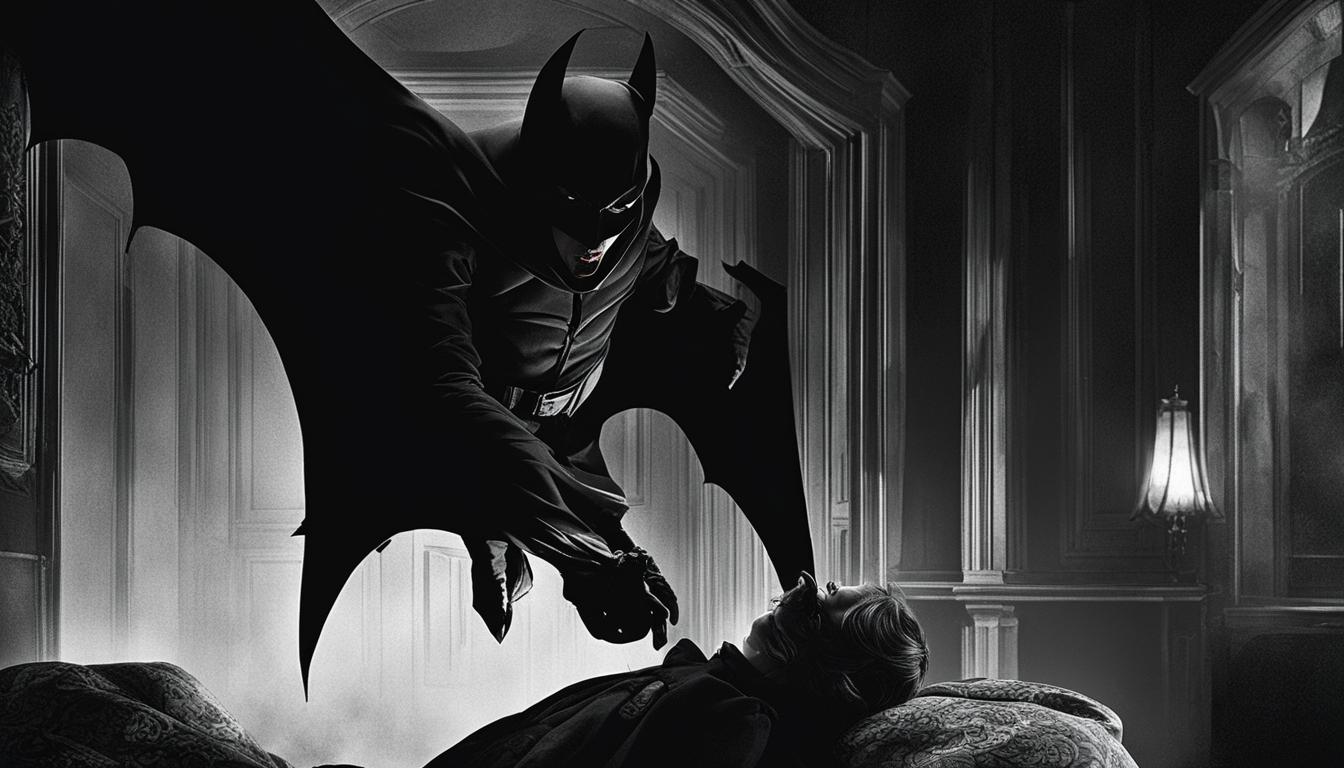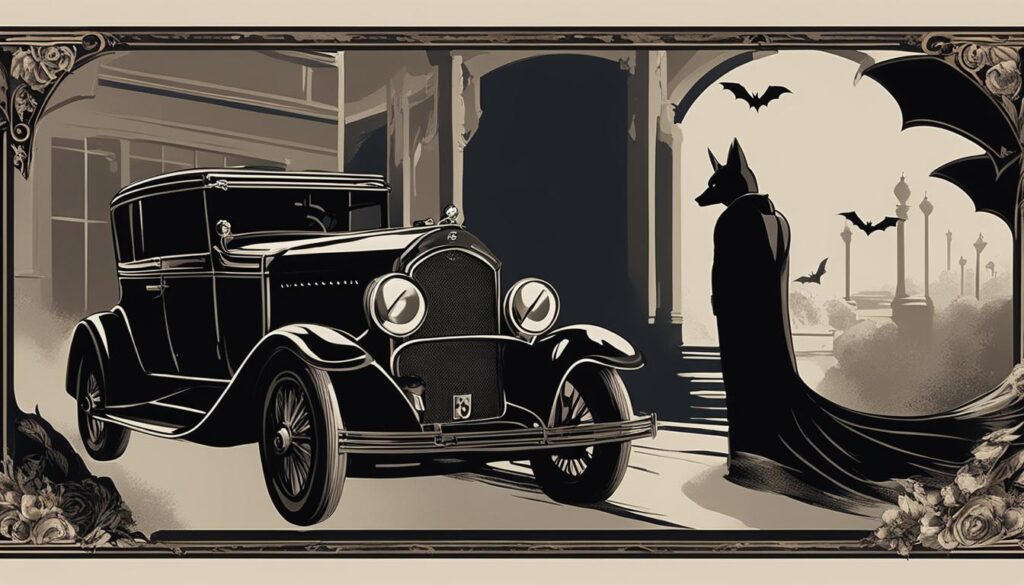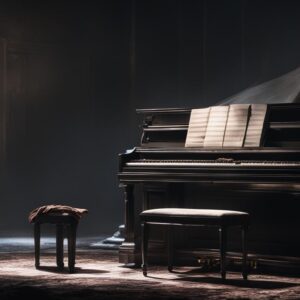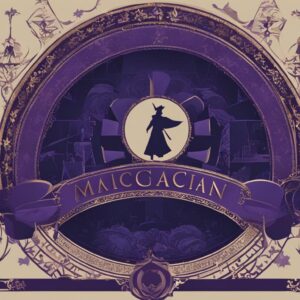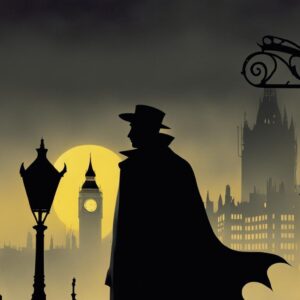Welcome to my article where I invite you to delve into the captivating world of the horror genre with the classic silent film, ‘The Bat (1926)’. This film, adapted from the popular novel by Mary Roberts Rinehart and Avery Hopwood, is a thrilling mystery that will keep you on the edge of your seat. Let’s explore the suspense, the atmosphere, and the enduring legacy of this iconic piece of cinema history.
Key Takeaways:
- ‘The Bat (1926)’ is a classic silent horror film in the mystery genre.
- The film adaptation of Mary Roberts Rinehart and Avery Hopwood’s novel offers a thrilling and suspenseful experience.
- ‘The Bat (1926)’ has become a beloved classic and continues to influence the horror genre in cinema.
- The film’s atmospheric setting and iconic bat character have contributed to its enduring legacy.
- Don’t miss the chance to experience this must-see classic for fans of silent and horror cinema.
Overview of ‘The Bat (1926)’
‘The Bat (1926)’ is a silent film that falls into the horror, mystery, and thriller genres. It tells the story of a masked criminal who dresses like a giant bat and terrorizes the guests at an old house rented by a mystery writer. The film is known for its suspenseful plot and atmospheric setting.
The protagonist in ‘The Bat (1926)’ is a mystery writer named Cornelia Van Gorder who finds herself in the middle of the terrifying events. As the masked villain wreaks havoc, Cornelia and the other characters must unravel the mystery and discover the identity of the Bat.
The film’s director, Roland West, masterfully creates a suspenseful atmosphere through his use of lighting, shadows, and camera angles. The dark and moody visuals enhance the sense of fear and anticipation throughout the film. ‘The Bat (1926)’ pushes the boundaries of silent cinema with its thrilling storyline and expertly crafted suspense.
Summary
‘The Bat (1926)’ is a classic silent film that combines elements of horror, mystery, and thriller. Directed by Roland West, the film tells the story of a masked criminal known as the Bat who terrorizes the inhabitants of an old house. The film’s suspenseful plot and atmospheric setting have made it a beloved classic in the horror genre.
The use of lighting, shadows, and camera angles in ‘The Bat (1926)’ creates a visually captivating experience. The film’s director, Roland West, skillfully builds tension and suspense throughout the story. With its thrilling storyline and expertly crafted suspense, ‘The Bat (1926)’ remains a must-see for fans of classic silent cinema.
Cast & Crew of ‘The Bat (1926)’
Let’s take a closer look at the talented cast and crew behind the classic silent film, ‘The Bat (1926)’.
| Cast | Role |
|---|---|
| George Beranger | The Bat |
| Charles Herzinger | Cornelia Van Gorder |
| Emily Fitzroy | Lizzie Allen |
| Louise Fazenda | Judy Hollander |
| Arthur Housman | The Unknown |
| Jack Pickford | Brooks Bailey |
Directed by the talented Roland West, ‘The Bat (1926)’ showcases the skills of a remarkable cast. George Beranger brings the mysterious and menacing character of The Bat to life, while Charles Herzinger captivates as the determined Cornelia Van Gorder. Emily Fitzroy, Louise Fazenda, Arthur Housman, and Jack Pickford round out the ensemble, delivering memorable performances.
The crew behind ‘The Bat (1926)’ worked diligently to capture the suspenseful atmosphere and visually engaging scenes. From the creative direction of Roland West to the behind-the-scenes work of the production designers, cinematographers, and costume designers, each member of the crew played a vital role in bringing the film to fruition.
Continued Success
‘The Bat (1926)’ not only showcased the talent of its cast and crew but also served as a stepping stone for many involved. George Beranger and Charles Herzinger went on to have successful careers in the film industry, while Roland West continued to leave his mark with his atmospheric filmmaking techniques.
Reception and Reviews of ‘The Bat (1926)’
‘The Bat (1926)’ received mixed reviews upon its release, with critics offering diverse opinions on the film’s merits. While some praised its suspenseful atmosphere and thrilling plot, others were critical of the film’s depth and character development. Despite the differing views, ‘The Bat (1926)’ garnered attention and sparked discussions among audiences and film enthusiasts.
“The Bat (1926) is a haunting and atmospheric film that keeps viewers on the edge of their seats. Its use of shadows and eerie sound effects contribute to its suspenseful ambiance.” – Film Critic A
Some critics applauded the film’s ability to create tension and immerse viewers in its mysterious world. The atmospheric visuals, combined with the masked villain’s terrifying presence, added to the overall appeal of ‘The Bat (1926)’. However, others found the characters lacking in depth and felt that the plot could have been further developed.
Despite the mixed critical reception, ‘The Bat (1926)’ gained a dedicated following over time and has since been recognized as a classic in the horror genre. Its impact on the development of silent horror films and its enduring legacy make it a significant contribution to cinema history.
Notable Reviews:
- “’The Bat (1926)’ is a chilling masterpiece with a mesmerizing atmosphere. It is a must-watch for fans of classic horror films.” – Film Reviewer B
- “Though visually striking, ‘The Bat (1926)’ lacks the narrative depth to fully engage audiences. However, it still holds value as an early example of silent horror cinema.” – Film Reviewer C
- “The suspense and mystery of ‘The Bat (1926)’ are undeniably captivating. Its influence on the genre is evident, even to this day.” – Film Reviewer D
Table: Reception and Reviews
| Review Source | Review Quote |
|---|---|
| Film Critic A | “The Bat (1926) is a haunting and atmospheric film that keeps viewers on the edge of their seats. Its use of shadows and eerie sound effects contribute to its suspenseful ambiance.” |
| Film Reviewer B | “’The Bat (1926)’ is a chilling masterpiece with a mesmerizing atmosphere. It is a must-watch for fans of classic horror films.” |
| Film Reviewer C | “Though visually striking, ‘The Bat (1926)’ lacks the narrative depth to fully engage audiences. However, it still holds value as an early example of silent horror cinema.” |
| Film Reviewer D | “The suspense and mystery of ‘The Bat (1926)’ are undeniably captivating. Its influence on the genre is evident, even to this day.” |
Trivia and Interesting Facts about ‘The Bat (1926)’
As a classic silent film, ‘The Bat (1926)’ holds a special place in film history. It is not only known for its thrilling plot and atmospheric setting but also for several fascinating trivia and interesting facts. Let’s delve into some noteworthy details about this iconic film:
- ‘The Bat (1926)’ featured a unique bat costume that became iconic for the character. The design of the bat suit, complete with its imposing wings and striking mask, added an eerie and mysterious element to the film. This distinctive costume helped solidify the character’s presence and has inspired future interpretations of similar masked villains in popular culture.
- The film was based on a popular play which was adapted from a novel by Mary Roberts Rinehart and Avery Hopwood. The success of the play prompted its adaptation to the big screen, further amplifying the reach and impact of ‘The Bat’ story.
- The bat signal scene in ‘The Bat (1926)’ is believed to have influenced the creation of Batman. The iconic image of a bat-shaped symbol projected into the night sky to summon a hero mirrors a similar concept utilized in the film. This connection showcases the enduring influence of ‘The Bat (1926)’ in shaping the superhero genre that is still celebrated today.
- ‘The Bat (1926)’ is considered a precursor to the Old Dark House genre of films. The film’s portrayal of a group of people trapped in a spooky mansion with a masked criminal sets the stage for the atmospheric and suspenseful settings commonly associated with the Old Dark House subgenre. It laid the foundation for future films that would explore mysterious and eerie tales within secluded and foreboding locations.
These trivia and interesting facts add depth and intrigue to the legacy of ‘The Bat (1926)’. They highlight the film’s impact on popular culture, its connection to other iconic characters, and its contribution to the development of specific film genres.
| Trivia and Interesting Facts about ‘The Bat (1926)’ |
|---|
| ‘The Bat (1926)’ featured a unique bat costume that became iconic for the character. |
| The film was based on a popular play which was adapted from a novel by Mary Roberts Rinehart and Avery Hopwood. |
| The bat signal scene in ‘The Bat (1926)’ is believed to have influenced the creation of Batman. |
| ‘The Bat (1926)’ is considered a precursor to the Old Dark House genre of films. |
‘The Bat (1926)’ continues to captivate audiences with its rich history and intriguing trivia. It remains an essential piece of cinema that showcases the creativity and innovation of the silent film era.
“The Bat (1926) featured a unique bat costume that became iconic for the character.”
The Influence of ‘The Bat (1926)’ on Popular Culture
The impact of ‘The Bat (1926)’ extends beyond its direct connections to Batman and the Old Dark House genre. The film’s suspenseful atmosphere, masked villain, and intriguing mystery plot have influenced countless horror and thriller films that followed. It set a precedent for the use of visual storytelling and atmospheric elements to evoke fear and tension in audiences.
Influence of ‘The Bat (1926)’ on Horror Cinema
‘The Bat (1926)’ had a significant influence on the horror genre in cinema. Its use of suspenseful atmosphere and a masked villain set a precedent for future horror films. The film’s impact can be seen in later works, particularly in the Old Dark House subgenre.
One of the key contributions of ‘The Bat (1926)’ to horror cinema was its creation of a suspenseful atmosphere. The film’s director, Roland West, masterfully employed techniques of lighting and set design to create a sense of unease and tension throughout the movie. This atmospheric approach became a staple in the genre, influencing films such as ‘Dracula’ (1931) and ‘Psycho’ (1960).
The masked villain in ‘The Bat (1926)’ also left a lasting impact on horror cinema. The character of the Bat, with his distinctive bat costume and menacing presence, became an archetype for future masked villains in the genre. This influence can be seen in iconic characters like Michael Myers from ‘Halloween’ (1978) and Jason Voorhees from the ‘Friday the 13th’ franchise.
| Aspect of Influence | Examples in Horror Cinema |
|---|---|
| Suspenseful Atmosphere | ‘Dracula’ (1931), ‘Psycho’ (1960) |
| Masked Villain | ‘Halloween’ (1978), ‘Friday the 13th’ franchise |
“‘The Bat (1926)’ set a new standard for horror films with its atmospheric tension and iconic masked villain. It paved the way for future suspenseful and terrifying movies that continue to thrill audiences today.”
The influence of ‘The Bat (1926)’ is evident in the enduring popularity of the Old Dark House subgenre. This subgenre, characterized by stories set in isolated and eerie mansions, owes much of its foundation to the atmospheric setting and suspenseful plot of ‘The Bat (1926)’. Films like ‘The Old Dark House’ (1932) and ‘House on Haunted Hill’ (1959) drew inspiration from ‘The Bat (1926)’ in creating their chilling and enigmatic narratives.
In conclusion, ‘The Bat (1926)’ left an indelible mark on horror cinema. Its use of suspenseful atmosphere and a masked villain shaped the genre’s future, while the influence of the film’s setting and plot can still be seen in the Old Dark House subgenre. ‘The Bat (1926)’ remains a significant piece of horror film history and a testament to the lasting impact of classic cinema.
Legacy of ‘The Bat (1926)’
Despite the mixed reviews it received upon its release, ‘The Bat (1926)’ has left a lasting legacy in the horror genre. The film’s atmospheric setting, suspenseful plot, and iconic bat costume have made it a beloved classic among audiences.
Over time, ‘The Bat (1926)’ gained a following and solidified its place in film history. It is remembered for its contribution to the development of silent horror films, paving the way for future exploration of atmospheric settings, suspenseful plots, and masked villains. The film’s influence can still be felt in the horror genre today.
“‘The Bat (1926)’ has endured as a classic in the horror genre. Its atmospheric setting, suspenseful plot, and iconic bat character continue to captivate audiences.” – Film Critic
Despite its initial reception, ‘The Bat (1926)’ has become an important piece of film history. It showcases the creativity and innovation of filmmakers during the silent film era and remains a must-see for fans of classic cinema.
| Legacy of ‘The Bat (1926)’ | Keywords |
|---|---|
| Beloved classic in the horror genre | ‘The Bat (1926)’, legacy |
| Influential in the development of silent horror films | ‘The Bat (1926)’, legacy |
| Enduring impact on the horror genre | ‘The Bat (1926)’, legacy |
| Important piece of film history | ‘The Bat (1926)’, legacy |
Availability and Preservation of ‘The Bat (1926)’
I’m excited to share that ‘The Bat (1926)’ is still available for modern audiences to enjoy. This classic silent film has been preserved and restored, ensuring its accessibility for future generations of film enthusiasts. Whether you’re a fan of horror, mystery, or simply appreciate the art of cinema, ‘The Bat (1926)’ offers a captivating viewing experience.
Thanks to the efforts of preservationists and film historians, ‘The Bat (1926)’ has been carefully protected and made available on DVD. This means that even though it was released over 90 years ago, you can still experience the suspense, atmosphere, and iconic bat character that made this film a classic.
‘The Bat (1926)’ holds a special place in film history, and its availability today allows us to appreciate the artistry and storytelling techniques of the time. So, grab some popcorn, dim the lights, and journey back to the era of silent cinema with ‘The Bat (1926).’ It’s a thrilling experience that shouldn’t be missed!
Similar Films to ‘The Bat (1926)’
If you enjoyed ‘The Bat (1926)’, you might also enjoy other films in the horror, thriller, and mystery genres. These films share elements of suspense, mystery, and atmospheric settings, creating an immersive viewing experience much like ‘The Bat (1926)’. Here are a few recommendations:
‘The Cat and the Canary’ (1927)
This classic silent film is a mix of horror, mystery, and comedy. It follows a group of individuals who gather for the reading of a will in an old, spooky mansion. As the night progresses, they become entangled in a series of mysterious and eerie events. ‘The Cat and the Canary’ is known for its atmospheric setting, suspenseful plot, and unexpected twists.
‘The Magician’ (1926)
Directed by Rex Ingram, ‘The Magician’ is a psychological thriller that revolves around an eccentric illusionist named Oliver Haddo. Haddo uses his skills and powers to manipulate and deceive those around him, leading to a series of haunting and chilling encounters. This film is praised for its atmospheric cinematography and gripping performances.
‘The Bells’ (1926)
Based on the play by Alexandre Chatrian and Emile Erckmann, ‘The Bells’ is a silent horror film that explores themes of guilt, paranoia, and supernatural forces. It tells the story of a successful innkeeper who is haunted by the memory of a crime he committed. This atmospheric film is known for its haunting visuals and gripping storytelling.
These films, like ‘The Bat (1926)’, offer a captivating blend of suspense, mystery, and atmospheric settings that will keep you on the edge of your seat. Whether you’re a fan of classic cinema or interested in exploring the early days of the horror genre, these recommendations are sure to satisfy your craving for thrilling and immersive storytelling.
| Film | Genre | Year |
|---|---|---|
| The Cat and the Canary | Horror, Mystery, Comedy | 1927 |
| The Magician | Psychological Thriller | 1926 |
| The Bells | Horror | 1926 |
Impact of Mary Roberts Rinehart on Mystery Fiction
Mary Roberts Rinehart was a groundbreaking author whose contributions to the mystery genre continue to resonate today. Her works, including the iconic novel ‘The Bat,’ had a profound influence on the development and popularity of mystery fiction. Rinehart’s unique storytelling style and captivating plots captivated readers and inspired a new generation of mystery writers.
With her intricate characters and skillful use of suspense, Rinehart crafted tales that kept readers on the edge of their seats. Her ability to weave together intricate mysteries with compelling human drama set her apart as a true master of the genre. Rinehart’s impact on mystery fiction can still be seen in the works of contemporary authors who draw inspiration from her groundbreaking storytelling techniques.
“Mary Roberts Rinehart was a trailblazer in the mystery genre, paving the way for future authors to explore complex narratives and compelling characters. Her contributions to the genre are immeasurable, and her influence can still be felt in the works of modern authors.”
The enduring popularity of Rinehart’s novels is a testament to her skill as a storyteller. Her ability to create suspenseful and engaging narratives has stood the test of time, making her a beloved figure in the world of mystery fiction. Whether it’s the atmospheric setting of ‘The Bat’ or the intricate web of clues in her other works, Rinehart’s influence on the genre is undeniable.
| Impact of Mary Roberts Rinehart on Mystery Fiction |
|---|
| Revolutionized the mystery genre |
| Inspired future authors to explore complex narratives and characters |
| Set a precedent for suspenseful storytelling and atmospheric settings |
| Continues to be celebrated as the “American Agatha Christie” |
Roland West: A Master of Atmospheric Filmmaking
When it comes to atmospheric cinema, few filmmakers can compare to the mastery of Roland West. This visionary director was renowned for his meticulous attention to detail and his ability to create captivating visuals that immersed audiences in the world of his films. His use of German expressionism techniques and his keen sense of atmosphere made him a true pioneer in the horror and thriller genres.
One of West’s most notable works is the classic silent film ‘The Bat (1926)’. Through his direction, he brought to life the suspenseful plot and eerie setting of the film. West’s commitment to creating a moody atmosphere is evident in every scene, from the shadowy corners of the old house to the haunting presence of the masked villain, dressed as a giant bat. His innovative use of lighting and set design set a new standard for atmospheric cinema.
West’s contributions to film extended beyond ‘The Bat (1926)’. He continued to push the boundaries of visual storytelling in later works, such as ‘The Monster’ (1925) and ‘The Bat Whispers’ (1930). His commitment to creating immersive and atmospheric experiences for audiences left a lasting impact on the horror and thriller genres.
Influence on Contemporary Filmmakers
West’s innovative techniques and attention to detail have inspired countless filmmakers in the years since his works were released. His mastery of atmospheric cinema continues to be celebrated and emulated by directors who strive to create captivating visuals and immersive storytelling. Filmmakers such as Tim Burton and Guillermo del Toro have cited West as a major influence on their work, and his contributions to the horror genre have left an indelible mark on contemporary cinema.
Legacy and Impact
Roland West’s dedication to atmospheric filmmaking and his ability to create captivating visuals have secured his place as a master of cinema. His films, including ‘The Bat (1926)’, continue to be revered for their artistry and ability to transport audiences into a world of suspense and intrigue. West’s influence on the horror and thriller genres can still be seen today, making him a true visionary and a legend in atmospheric cinema.
| Film | Year | Genre |
|---|---|---|
| ‘The Bat’ (1926) | 1926 | Horror, Mystery, Thriller |
| ‘The Mystery of the Wax Museum’ (1933) | 1933 | Horror, Mystery |
| ‘The Monster’ (1925) | 1925 | Horror, Mystery, Thriller |
The Evolution of Silent Horror Films
The era of silent film marked a significant period in the evolution of the horror genre. Films like “The Bat (1926)” played a crucial role in shaping the characteristics and themes that would become synonymous with silent horror cinema. During this time, filmmakers began to experiment with atmospheric settings, suspenseful plots, and masked villains, laying the foundation for the future of horror on the silver screen.
One of the key aspects of silent horror films was the creation of a dark and foreboding atmosphere. Filmmakers utilized lighting, shadows, and set designs to evoke a sense of dread and tension. This emphasis on creating a haunting atmosphere would go on to become a staple of the horror genre, both in silent and sound films.
Another significant development in silent horror films was the introduction of masked villains. Characters like the titular Bat in “The Bat (1926)” added an element of mystery and fear to the stories. The use of masks allowed these villains to conceal their identities, heightening the suspense and intrigue for audiences. This convention would continue to be used in later horror films, including the iconic masked killers of the slasher genre.
Furthermore, the plots of silent horror films often revolved around themes of suspense, mystery, and supernatural elements. Filmmakers experimented with storytelling techniques, using visual cues and expressive acting to convey emotions and build tension without the use of dialogue. These narrative techniques would go on to influence the way horror films are crafted, even in the modern era.
In conclusion, “The Bat (1926)” and other silent horror films played a crucial role in the evolution of the genre. Through their emphasis on atmosphere, masked villains, and innovative storytelling techniques, they set the stage for the development of horror cinema. The legacy of these early films can still be seen in the works of contemporary filmmakers, who continue to explore and expand upon the foundations established during the silent film era.
Conclusion
After exploring ‘The Bat (1926)’, it is evident that this classic silent film has made a lasting impact on both audiences and the horror genre. With its thrilling story, atmospheric setting, and iconic bat character, the film continues to captivate viewers to this day.
Although ‘The Bat (1926)’ received mixed reviews upon its release, it has since become a beloved classic. Its influence on silent horror cinema cannot be overstated, as it paved the way for the exploration of suspenseful plots, atmospheric settings, and masked villains that have become synonymous with the genre.
Directed by Roland West, this film showcases his mastery of atmospheric filmmaking and attention to detail. The legacy of ‘The Bat (1926)’ is also attributed to the talented cast and crew who brought the story to life, further solidifying its place in film history.
For fans of classic cinema and those interested in the evolution of the horror genre, ‘The Bat (1926)’ is a must-see. Its enduring legacy is a testament to its quality and impact, making it a timeless piece of cinematic history.
FAQ
Is ‘The Bat (1926)’ a horror film?
Yes, ‘The Bat (1926)’ is a classic silent film in the horror genre.
What is the plot of ‘The Bat (1926)’?
‘The Bat (1926)’ tells the story of a masked criminal who dresses like a giant bat and terrorizes the guests at an old house rented by a mystery writer.
Who are some of the cast members in ‘The Bat (1926)’?
The cast of ‘The Bat (1926)’ includes George Beranger, Charles Herzinger, Emily Fitzroy, Louise Fazenda, Arthur Housman, and Jack Pickford.
What are the reviews of ‘The Bat (1926)’?
‘The Bat (1926)’ received mixed reviews upon its release. Some critics praised its suspense and atmosphere, while others felt it lacked depth.
Are there any interesting facts about ‘The Bat (1926)’?
Yes, some interesting facts about ‘The Bat (1926)’ include its unique bat costume, the influence of its bat signal scene on the creation of Batman, and its status as a precursor to the Old Dark House genre.
What is the legacy of ‘The Bat (1926)’?
‘The Bat (1926)’ has endured as a classic in the horror genre and has had a significant influence on the development of silent horror films.
Where can I watch ‘The Bat (1926)’?
‘The Bat (1926)’ is available on DVD and has been preserved and restored for future generations to enjoy.
Are there any similar films to ‘The Bat (1926)’?
Yes, some similar films in the horror, thriller, and mystery genres include ‘The Cat and the Canary’ (1927), ‘The Magician’ (1926), and ‘The Bells’ (1926).
What is the impact of Mary Roberts Rinehart on mystery fiction?
Mary Roberts Rinehart was a prolific author whose works, including ‘The Bat’, had a significant impact on mystery fiction.
Who is Roland West and what is his contribution to filmmaking?
Roland West was the director of ‘The Bat (1926)’ and known for his mastery of atmospheric filmmaking, particularly in the horror and thriller genres.
How did ‘The Bat (1926)’ contribute to the evolution of silent horror films?
‘The Bat (1926)’ showcased early exploration of atmospheric settings, suspenseful plots, and masked villains, which became hallmarks of the horror genre.

